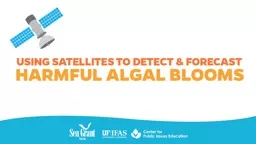

HABs occur when colonies of algae simple plants that live in the sea and freshwater grow out of control and produce toxic effects on people animals or ecosystems Florida experiences different types of HABs such as ID: 929290
Download Presentation The PPT/PDF document "What is a Harmful Algal Bloom (HAB)?" is the property of its rightful owner. Permission is granted to download and print the materials on this web site for personal, non-commercial use only, and to display it on your personal computer provided you do not modify the materials and that you retain all copyright notices contained in the materials. By downloading content from our website, you accept the terms of this agreement.
Slide1
Slide2What is a Harmful Algal Bloom (HAB)?
HABs occur when colonies of algae — simple plants that live in the sea and freshwater — grow out of control and produce toxic effects on people, animals or ecosystems.
Florida experiences different types of HABs such as:Red tide: caused by algal species Karenia Brevis; occurs along coast.Blue-green blooms: caused by cyanobacteria species; occurs in fresh, brackish and salt water.
Slide3Symptoms of HAB exposure
HABs produce toxins that can be detrimental to the health of humans, pets, livestock and wildlife.
Potential symptoms of HAB exposure include but are not limited to:
Respiratory irritation
Itchy/ irritated eyes
Skin rashes
Slide4Satellite images of HABs in Florida
High concentrations of
K. brevis
during a red tide event pictured off Florida’s west coast in 2018.
Most ocean color imagery uses a color palette ranging from purple to red as algae concentration increases.
Plant pigments in algal blooms produces a visible color change in water.
This color change can be detected by satellites in the Earth’s orbit.
Slide5Satellite images of HABs in Florida
High concentrations of blue-green algae pictured in Lake Okeechobee in 2018.
Hotter colors represent higher concentrations.
Slide6Why use satellites to detect and track HABs?
Benefits of satellite imaging:
Satellites cover larger areas than a person could on the water.Satellite images are more sensitive than the human eye.Satellite images tell scientists how large a bloom isand what direction it is heading.
Slide7Limitations
Satellite data does not identify what species of algae is responsible for the change in water conditions.
Water conditions right along the coast are difficult to distinguish.The first pixel in satellite images is a mix of land and water, which can distort information.Smoke or smog on land can make accurate readings of the coast difficult. Satellite data alone cannot determine toxicity of a bloom. In order to determine if a bloom is harmful, scientists must combine satellite images with field samples.
Slide8Other ways scientists forecast blooms
Along the Gulf Coast of Florida,
K. brevis red tide respiratory forecasts are produced using satellite imaging by the Gulf of Mexico Coastal Ocean Observing System (GCOOS). Forecasts are communicated to the public in near real-time, projected over 24 hours and updated with the latest wind models every 3 hours.
https://
habscope.gcoos.org
VISIT:
Slide9How to use HAB forecasts
HAB forecasts can be used the same way as weather forecasts— to plan beach walks, waterfront dining and other outdoor activities.
Citizens can use HAB forecasts to make informeddecisions when visiting an area experiencing a bloom.
Slide10HAB Resources
For more information and resources related to HABs in Florida, visit
https://www.flseagrant.org/habs/